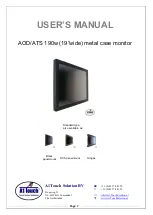
Advanced Error Correction Code (lockstep)
Advanced Error Correction Code (ECC) mode extends SDDC from x4 DRAM based DIMMs to both x4 and
x8 DRAMs. This protects against single DRAM chip failures during normal operation.
The installation guidelines for memory modules are as follows:
• Memory modules must be identical in size, speed, and technology.
• DIMMs installed in memory sockets with white release levers must be identical and the same rule
applies for sockets with black release levers. This ensures that identical DIMMs are installed in
matched pair —for example, A1 with A2, A3 with A4, A5 with A6, and so on.
GUID-4E0D57EB-0369-4D2F-9B34-9CF1CE1058B5
Memory optimized (independent channel) mode
This mode supports Single Device Data Correction (SDDC) only for memory modules that use x4 device
width. It does not impose any specific slot population requirements.
GUID-5C2CC231-2DE5-4CBD-A7F3-A9F46A570D89
Memory sparing
NOTE: To use memory sparing, this feature must be enabled in System Setup.
In this mode, one rank per channel is reserved as a spare. If persistent correctable errors are detected on
a rank, the data from this rank is copied to the spare rank, and the failed rank is disabled.
With memory sparing enabled, the system memory available to the operating system is reduced by one
rank per channel. For example, in a dual-processor configuration with sixteen 4 GB single-rank memory
modules, the available system memory is: 3/4 (ranks/channel) × 16 (memory modules) × 4 GB = 48 GB,
and not 16 (memory modules) × 4 GB = 64 GB.
NOTE: Memory sparing does not offer protection against a multi-bit uncorrectable error.
NOTE: Both Advanced ECC/Lockstep and Optimizer modes support memory sparing.
GUID-C028BC5D-CF38-4517-A533-BD1B8BA71DDC
Memory mirroring
Memory mirroring offers the strongest memory module reliability mode compared to all other modes,
providing improved uncorrectable multi-bit failure protection. In a mirrored configuration, the total
available system memory is one half of the total installed physical memory. Half of the installed memory
is used to mirror the active memory modules. In the event of an uncorrectable error, the system switches
over to the mirrored copy. This ensures SDDC and multi-bit protection.
The installation guidelines for memory modules are as follows:
• Memory modules must be identical in size, speed, and technology.
• Memory modules installed in memory module sockets with white release levers must be identical and
the same rule applies for sockets with black and green release tabs. This ensures that identical
memory modules are installed in matched pairs—for example, A1 with A2, A3 with A4, A5 with A6, and
so on.
Table 31. Processor configuration
Processor
Configuration
Memory population
rules
Memory population
information
Single CPU
Memory population order
{1,2}, {3,4}
See Memory mirroring note
78
















































